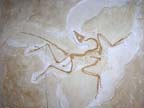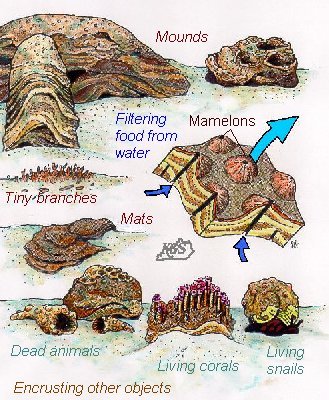 |
 |
 |
 |
 |
Produced
by the Population Genetics and Evolution class, Furman University |
||||
 |
 |
 |
 |
 |
Produced
by the Population Genetics and Evolution class, Furman University |
||||
 |
The
Ordovician: Stromatoporoids |
 |
||
| Stromatoporoids,
though once classified as ancient corals or cnidarians, are now considered
to be massive, calcareous sponges (Phylum Porifera) occurring first in
the Ordovician era. It is due to their calcareous nature that they are
so easily preserved as fossils (Kaslev 1999). They come in many shapes,
including tabular, encrusting, and arm-shaped. Common features include
mamelons, or irregular lumps on the surface of the massive skeleton of
the organism, presumably used for expelling water that had been filtered
for food (Kentucky Geological Survey 2006). Each mamelon is associated
with a channel called an astrorhizum, through which the filtered water
flowed. Relatively recent discoveries of modern sponges in Astrosclera
with similar structures are what place the stromatoporoids now among Porifera
(Collins 1994). Sediment carried with the water would be deposited across
the surface of the organism, whose living tissue, much like the corals
of today, resided primarily on the outermost layer and grew upwards. Over
time, this sediment would encrust both other living objects such as corals
and snails, and organic detritus (Kentucky 2006), with layered “colonies”
of stromatoporoids that in the later Devonian era have been known to make
“reefs” as deep as several hundred meters (Kaslev 1999). Page by Will Towler |
 |
| Features of stromatoporoids. From: Kentucky Geological Survey. | |
| Collins A. 2006. Stromatoporoids. University of California Museum of Paleontology. Accessed Feb. 7, 2010. Kaslev M. 1999. Stromatoporoidea-1. www.palaeos.com. Accessed Feb. 7, 2010. Kentucky Geological Survey. 2010. Stromatoporoids. Accessed Feb. 7, 2010. |